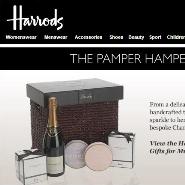
Approximately 14.7 percent of retailers inquire about why customers unsubscribe from email blasts, a sign that many brands are not really listening to their customers, according to a new study from Epsilon.
Luxury brands specifically need to pay attention to what their customers want to know or what they need. Not inquiring about an email unsubscribe could show that brands only do not care that they are losing a customer, but that do not care enough to take steps to ensure that they do not lose more.
“Brands need to listen to their customers, so that they can make the appropriate changes to their marketing programs based on individual consumer preferences,” said David Meier, senior account director of digital solutions for Epsilon, Irving, TX.
“Most likely, they’ll find that the answers revolve around relevancy and frequency, which are all easily controlled by the marketing team and can be adjusted to suit the individual’s preferences,” he said.
“Marketers that understand the behavior and preferences of their customers can create the most effective marketing program and avoid additional unsubscribes.”
Email clicks
Email is a completely opt-in service, so brands that take advantage of this service need to be careful about the content they send.
Obviously, brands are going to have customers that opt-out of email blasts. However, brands should be taking this opportunity to discover why, and what they can do to stop this in the future.
“Brands should leverage data and focus their email strategy on relevancy, overall customer experience and the benefits of the brand relationship to the customer,” Mr. Meier said. “A data-driven campaign that is tailored to the specific preferences of the individual will ensure the most effective strategy and prevent unsubscriptions.”
In the study, approximately 55.6 percent of retailers surveyed required two clicks to unsubscribe from branded email communications and 99.8 percent featured the unsubscribe link at the bottom of the emails.
Furthermore, 22 percent gave subscribers a chance to change the frequency of the emails while 35.8 percent offered subscribers a chance to remain subscribed during the unsubscribe process.
“In the near term, you may be losing a record from your email file but that may not be a valuable relationship to begin with,” Mr. Meier said. “This behavior should help you better understand the value of specific offers, creative, subject line and frequency.
“In the long-term, analyzing unsubscribe behavior and understanding the reason behind it should build to a stronger program,” he said.
Going for strength
Many luxury brands use email to send information to their customers, some more frequently than others.
For instance, Saks Fifth Avenue sends daily emails alerting customers about a site relaunch, free shipping and special promotions (see story).
Meanwhile, British department store Harrods tries for online conversions with emails that promote on-site products (see story).
Brands cannot stop their customers from opting-out of emails, but instead of looking at it as a blow, companies can use this as a way to encourage customer feedback and strengthen their tactics.
“While some email marketers are doing a better job than others, we have yet to see a retailer who has ‘perfect’ execution of an email strategy,” Mr. Meier said. “To be spot-on and to improve campaign performance over time, marketers need to recognize the investment needed – both staffing and resources – and need to fundamentally shift some of their marketing goals and strategies.
“Brands should know your customer and use data and preferences to develop a strategy that is relevant and timely,” he said.
{"ct":"\/CCWGzp2qbm1Tkd0EBLjIKCsodesSwRbPclxPFIlXc5jsUJ0uifcnWOJDt4bbgRVQY5gAqz8jxqvhtdw0z06+pTboA8OdJ4pr5Je\/iF3JgoILjLABxrzaBkmYzPYTNQPjpm5ydNV\/AX+wxKnAplD6g1r5frTafrgmVss06XlnrC5f+PSluXst\/nDfy4gIbduxoauKwpV0EU+MuoEDf7xahJuLmwkJA2JU7sLlxCj7EZr1q8I70oZh+GxocLi5krgQA5gfSUOStKg7eFHvsz8WQtLl9pVNpwwTmKbSOJtq38Vvrre5mRbiiOk4OQMDZYak2FB1YnLPOzPoLKU6j8KGYCmhKA2O5\/jip4YkSK5v\/r3YkhnPWQxmMXuEWS7I2gojSqfl2D1bU92dFWXmpOO0MVuLRbodyt6whdxjBEhbfFps4eZMLru4cEieo2qa9YDzcCrWg8\/rNcHvrE5nIdlzrc0L7POj0IHRAbOSKpP1gGVstuUEGJ7nXrKpsiBOUnNUj2lOEeY0pPOxboIyknWSOLa8c5AfyI\/k8EujVgXSgXhz8HAB5tuhHK\/WW5QvN9yQTaejcLHGPKiCLFHF3V1opU6BmyPg2NbgNv5muxpKjoOLzkiqz2Jj5Mf2IqdAEJj5s4aK2t1P5YGbpHVq0EHetrj\/AYhjMUXDt63Xf0UDABcnoP90vPoi3eUVErr8R0NgqVtX74pm9mqvze6Plb9R9INEA\/YuAUFJ5GXfpHcakV\/D6pPg6GhYrhS61HgaLH0xGQ0DLtXqg+sowqFUqMH3bFV5jT58nDEnJFrtEtquZDBTE2\/bDU3kTI4ud98FUfkcp1OgJjyhyZU+LkNELkjjx2sGEw3abR+GA6meNDBg7wmuJQbhMoqZIILc7hfuK\/l8WG+Gw9UAYuE5ARafvkvvlEZQyfJLi7lHq036uGXe0PCraFoI0hUNXYHNVlpyzyM5gOLPWF33gsSf2zGDpc9PR5lpuHKZMYrTWM2rRC\/hDL9bGUTlbJrxUKmRqVJ3CX6FotP\/sqKTb9EPdhaVULMi1A9QuzAcc1XeJVzdeHl0u5wncsoQxcZ+dP6tWLujW5BWnfCgoTG1pI498cfqmJq1Cykt7t6AxV6vlqVOgUHjyQZ0kCo7bcVsPtPcvd+jjCXETmgPdpdQcnVUgKpsiP8MjlaytiOGUfy6d88AA+w+HEFhMnIm0WVyfOTyqM7nks0feIbhH8Fcyw4sKFxiJImq3mDFzB2789H8Lr+W\/B6Y\/0Vtc1SRJpAs9FYZrY3tlKq8UnbMSj3eEJVW951\/nTWtAgnVg4IOoE+r70SXgkiqrDav1EB01nUkUfnb8UCelxaCadHHbeMd8Mn8f7qOFE0Ujx+jFqAeJtWOz1z+1ot2m3jNDX9oz3G5On7jxCSne2GaYaL840YraI4JIJTC9atI+8ov4Bbjuv2TF5\/mT99i3njFndeisdL8y1ZWRYUQQYMBu5NFa9QrO6rT4XOHf6hpSEXOICb\/Sy2QoG2OGAQ+F6tzLekGAZ6eRxXMpOaVFyned+TGVfT0LS9plNrqPu+XtQF7X4N4NvVNTvBQHU8l18rhsZ4idok4GNdxdIviFfPZwWhigV\/jcJFp6cQEyaqH9Bowtnu+juZ357JHu4sMkUrlc5NQomg\/RoafmoPUg3nqAnd7WI2amZAkafPEGxP73cuORwhfgwmNQbLOPyy6ci1LmXlL2NgbWhHDN\/4xXQbHTzKIvPwuDhY3durT7zGJBPK8VA3+Is0EWbepw22BUCY1ERddYAZonhqak+qt3nkzGKhjcVsAvZSq+AfnaOt+AahOMWqtx7u0WSrg9lKk8tTrKUDmpbGvNlkZ9eQCUOhOmNqGQsMqt2Vxz0bwKWpMBjCCYCPX40L3GSt+42qvfoW46fWeFkrRy528jioO81oFH4lNnMSFEAxPN43PA3OLi\/QIcsKijy4ESNWM0kD2CAXc41o4hJOjF24A\/iyqDGCy8LRmF70BBgGHMOE2nW\/c8HRnHr\/Xr+Wk91sd1PI3j\/ppPngUPasWsbNmpxYuczK2uQuwUXmTQ1nlMxKpCpfXJR31T3TuUYe1PX7D4JMt5TzGJeqWZKdTJaVEeycN6HFTPq5MDJtaEGQIKFyG6jxQ+ToH+uyyEYeH04OKVdJt\/Sz8NqvEaY2RXo5\/ii6bGZyiIYaufx2vA2jB8QrL6DwA0lvBxdc3DwXJFtxWAl8FjQLkKhMT9Uk4fztP0Wwpfh98XfjbvuB\/Msh3gw0i0fdci4pYzWcO3jg9HB0f2MGxhbwKQfJg7NmnYiq7Ihfe4nH0QchmaPTpen\/gvGHBmmK\/ME4qQcPmsGjjZvH1rYVNZZf+W8QyCNbEnQy28A456jClC1w2Cehb2U4bhCj8hAyZjhKOOSbtrQGIkzxgoIg6YBhFyzPlZxmkWXbUKhvzWRK2UbliaLT6a2K+1cJzu0CFWirKvx63VsZeZKYw1JzvNjI1Cck9qyfZHrUYxrUHqMK5n7q7GZGgvIjl13ibN7bfsYHd8G3Y+8BDQe2brZuGWV5nfN4zKaL1szxbMqMT4IayC7nHRVLIjrvYs68ZBJUXPuxNhq7715RW+DX0GyAWK1y70t6xSnhxtONgrMK8Et+TjyRB2AwUUpa0b7ZVB+3dYxZx90FuR\/cdBAlNfTBUT5Zm3xQ3vCsLSYVmbIpWMAo4VcDkhPYtKIf1D+wrwgUPNluHfsVAotw36OxMOG\/1Is+tvCH59yU6FvGUy3ncPdLoOpv7xnstvZB3fAIk7NrFoR0TGbkALs\/uAzaTcnr0tLeM5IUQ4rxrWsH75CsGXQlhXSkNJF83scrF5xQ3RNzgvfay0WxX7dYKmUinmNAsGXkdET\/d2MvkxOubTpJ8K5vWBXVAWjDxKxWibn212L5Rs6Fugv+7afk+IrqCUVQMUzLDxq3oIkf46XqyxPEaP8VOhn+QN6t+KXArWpYK9YLqmu7F04\/jg4dQf7826xkvEQcMret\/F\/yv9k\/2Mity+WGHFY9J+KimU97aw8t5+UAr1cMs\/6Vl8SptdvNPsssY6YJB1k6NOIQZCJtTN4pFr+SmbrGnz6xNS9IT2mrFSd6tvuppNslzJdk+a7x+B1aB87n\/cZ9tcbVjkAW3Q6hJL21O72h\/1Ge7E5MNz4OFEtNevJVNIV4UWLbWUUpcglugJRXa+pRAx8I0Wtxg8lBWV4yET5kXvw41gHSNm0w\/on5qxc7RM9m77qUXJXiIIW2USzqoP3Hh6qWtBQMZ5WN3DgPldzXlApVLR7sPJlCRM4\/HuTk7HNiLFRqeH8sIhaLSrQlQnasyQXiBWMxhmrYHF\/ijwqoGIRQnXK3cZ+qWhkJ0mTj908kVvHFfGtXPYETwTKUvSGRxlGQpDAdO\/SjDnDN7WsMsVbSGcPbQL6vckgIVzMhlF8Au\/CksXNHv4Ui5aBZK2aYJO34IE5td0dhOPd6qIYXbmw53340ksP1y4JPq5kt6pYuGoxr5bCmOJcNV1S6g9NqkVpBA3wn0s+GIMOhfdwMZCF1zfAGs09EBLuyUgkNqzH\/57A1Z+ENT5mpbiFW4y6REXDq9mO5B\/M7qwuN+6jSv9z+qoBSiOZJ5HwATkQNd+zEZtnoXflbIhrKh\/Qks3BnbuInN0lAbIH3ioH02LoflmzwI08Md3dRErsNDfhgY147gMPkmaOEoxUHu3Y8A0o\/QIZwiHshxSWXlqW6\/giMPEm4F6v+\/hvt2cSTzHm3ZLaU4hdN0DdasT8OCqF35fjrVc54XlKdao3rBi9DgpHl9qliFUtc\/iHSlzio1186UFKfLnoQRdWJLtVdcRS0040C3JiJHCh1hf1lSkogv2RLJCxNEYuPHbt4z1vMIyeg\/5aOafPcAWP4Bor3fWCzpNC9E66yzZQWPU189FJ1hH5bfsah3wavO5iE9VKbes+GewcGk3iKYWIufyrAj74\/Jk51ddP5yZVBiCKwjofUiuPC2KcKQUU2Jb34oyM8fnxkToWprLOkRjcBvQK2XZcw8jANDl6vScohMYkD5HKJPrzpQZEK8PfBoscWkN4yHD7R37iWw3VvUlUTpriI9GXuOMf+VAj53itGCiqBKXFhCkV6cgfHXuQWbEQMYwc4k8uAMGfabpcpxMPMSSsxCWTz2WES015XuG7kcVJPZkiH3BQSXPoDBtvvLl9yIk+MUMf1xG\/Mc10XWs6nuRKzDJeB81+4QyiJfIMmHtq0uypFxI3l8iYVj8Wu92+BFQV+JDBAeCjT\/4e8lAmir2WLO7VScbsW2AUerAAh0+IuRDP1AOHEP9r3zCBMBGcVrx\/hrxO4d0ByUNvLW2SxiqBvg9dZPPEHQpHBklaciBI0OKfdT1+mfJHWLtukbtxOaFoJ58vc3rfPBKx+U9EJzTZWAERVZ1BjKNy5eNP1Z2pGH6O9GXsa2lk9cR2AdP9BQX8Ot1RVXFn7d\/WbisdtlUqEpiC5F8fJsbglCIQg4SqFws2TUjC\/fGMGTxoTKxM9vxBf287pKn7k9t1u7r2yRyL+KJNjz4EUSEAlosMkf8X5P0c2I7wrJ\/fVySUYE6znGeFxja4iqdbuLlcH64aDCKyve7UKXkdrTdJ6ck3WlQyA8p7wkg1SSwEKtZFBk\/eFPR6rZ8ufwN2gsCIkIHCdPc1i\/WtsYVliUUP0I2xK2mnR82VErFxHPRcmtXPPiTr8fR6vekk+AoQTqq3aUlVqf0tcc5jwGGytNcT90LWFX6h8iXnz1JAHvN8W5kkdSTJO6+7tRMdEkNB++7rJoWqKXCoyOL4A6aAhN3ndqd8w3mXh4QYKIvi0zAaMPaBRk4DDCDleVPoiF0zmhu25qQ5VgXPv6x4oH7CAdT8OcppImskna9QMryBQbuYM\/E6w4QpLCR+U0vfSjwzScxTMfqCyW0X6inE3GWsZYY9U1ECSrXJmxKyY+ztJsKIP4QX8xROEyX5UNrHl+MEEM6y4pbZeQks0xvLYUcQLFr5KxTKMXakWFNA2nHIniVQjaiCONGyzHFKDH0Lo0CfEkFberMwri\/j7QumgnU64jFsBo8I5WFy8R0HOg\/G\/ZO5X86VGlpo17LzgF7oT7QcURk7ykPjpcng26QK\/gP2NbuWZrJtqO5SgmICmVNZl9AKuFSiH48XuoGrYX00+tZUrj7lTtNQnU+F\/bguR+12EZtWkIiUlUOeCtOyFZjT+eRREYhvHqjNSQSuKiX\/DQ39+y0iEBlZmmU95PuF6vHt+tdCm\/ryfCBND1GVHLcfO8VRrDwilgfjDYtO0\/Ce7er1yUlMDMKNbJksSJrOqIKd8wKVExf+5YU4KmU1ZJOCKlkyVhSYGHz97joWNZEUR31ELFVs0OLJ\/wrwbDP3fYbipORH1zcd5GGJH4bq+Bv0fVPK+9GGYgpEOhsDrNhkUoR\/wwdW6tBoAPdfJU27bJ6nKctIVCRqC9GfL9hS5unoPwGpqwCRGNST9OZxIF7zcxJyQKLjI5PA1wHf7PV4CJBaabKvHpxk6UsvTq758rMdu\/SIehKzDlSzUE4SC2aimViCWAdqXNtLnQ6lwTrc49ZDJRgKWxlwRO4KDSFS1zI19YLqxQNW75xxND3EU3RWOe7gPuxwQJDIaB\/teOpyG2Qe699BFJdV8HM91wHR7To\/4VmsBgBVIlqUvKAwfSDycqSmRiLPcktjOvNTTNkpJ4QfF9Wo+4Enk7X8Ox41BFR7NSBoAyeHwB+BwJp37UKbsXObbO9Luo7JH899b9v+8+K\/pcQ5bQyyjZA87z84z8+kz6zxpToilXBIHIqiLVM22wFqhshCD7kTLAJo4WWViSwYeraqadJhxK9lQ3p5FXDFpzws13Ii1lE3SeyVhXIXvuRCgLxAlQFX+uipVV6Q7Z6h2Wx1SAM9pizBZEQ9YF+BXmxblr9kYGdIawVkPDi\/z7+egkvej97lY7n7GL6F4VEYwILkolL41wkzjug9JyaKKmuQSzTKQxeoDhrQ0xth\/Tpr\/+Mz3lAGwW5Zrf+cypgBEqpFokH\/sbOC\/EXEBDkRBxLpNmkmFHluvKIFja7aB8svEBgx83LE116HwOvOQ\/ew29nfe58qHjF18brgqMq6HOvqBv3EPn5mJ1\/FlwGiIc1J7Yqv45gJ9AItHGgxcQLdySWSnZ\/Z8vSacpFlg5RiDnxXnzgaCakVnCekqOhzyCtEK\/WSfEiSgxUTE2PvocEYzLkyP6ANzWLbIHY+LcBgz8qIChsG3vtOhVMCCFA==","iv":"eb95693edd58fd6b31d224afcc27ff60","s":"1f06cd159b20c391"}
